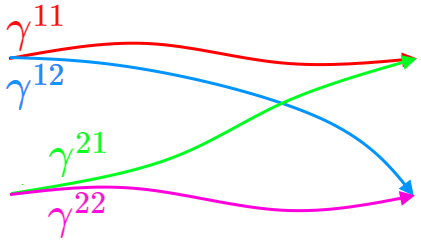Fix $n$, and let
$$ \Gamma = [d]^{n+1} = \{ \gamma = (\gamma_0, \gamma_1, \ldots, \gamma_n) : \gamma_i \in [d] \} $$
be the space of length-$n$ paths in $[d] = \{1, \ldots, d\}$. We also define
$$ \Gamma^{⧖} = \{ (\gamma^{11}, \gamma^{12}, \gamma^{21}, \gamma^{22}) \in \Gamma^4 : \gamma^{i1}_0 = \gamma^{i2}_0 \text{ and } \gamma^{1j}_n = \gamma^{2j}_n \}. $$
That is, $\Gamma^{⧖}$ is the space of all quadruples of curves $(\gamma^{11}, \gamma^{12}, \gamma^{21}, \gamma^{22})$ that form a configuration like below:

Then with $d\times d$ matrices $X^{(1)}, \ldots, X^{(n)}$ with IID $\mathcal{N}(0, d^{-1})$ entries and $C_n = X^{(1)} \cdots X^{(n)}$,
$$ \| C_n C_n^T \|_F^2 = \sum_{(\gamma^{11}, \gamma^{12}, \gamma^{21}, \gamma^{22}) \in \Gamma^{⧖}} \prod_{\substack{t \in [n] \\ i, j \in [2]}} X^{(t)}_{\gamma^{ij}_{t-1},\gamma^{ij}_t} $$
Expectation. We observe that, for the product $\prod_{t \in [n]; i, j \in [2]} X^{(t)}_{\gamma^{ij}_{t-1},\gamma^{ij}_t}$ to have non-zero expectation, each of the factor $X^{(t)}_{pq}$ must appear even number of times in the product. This forces the paths $\gamma^{11}, \gamma^{12}, \gamma^{21}, \gamma^{22}$ to coalesce. Among such coalesced configurations, the most abundant pattern is of the form

Since the "quadruple joint" in the above figure can occur at any of $t = 0, 1, \ldots, n$, the number of such configurations is $ (n+1) d^{n+1} (d-1)^n $, yielding
$$ \mathbf{E}[ \| C_n C_n^T \|_F^2 ] \sim (n+1) d^{n+1} (d-1)^n \cdot \mathbf{E}[(X_{pq}^{(t)})^2]^{2n} \sim (n+1)d. $$
Remark 1. Numerical simulation suggests that
$$ \mathbf{E}[ \| C_n C_n^T \|_F^2 ] = (n+1)d + \frac{n(n+1)}{2} + \mathcal{O}(d^{-1}) $$
as $d \to \infty$ for each $n$. When $n = 1, 2$, this claim can be directly verified by the exact formulas
$$ \mathbf{E}[ \| C_1 C_1^T \|_F^2 ] = 2d + 1, \qquad \mathbf{E}[ \| C_2 C_2^T \|_F^2 ] = 3d + 3 + \frac{3}{d}. $$
Remark 2. It seems that $\mathbf{Var}[ \| C_n C_n^T \|_F^2 ] = \mathcal{O}_n(1)$ as $d \to \infty$. For example, we have an exact formula
$$ \mathbf{Var}[ \| C_1 C_1^T \|_F^2 ] = 36 + \frac{40}{d} + \frac{20}{d^2}. $$
I will revisit this idea and try to (1) articulate more rigorous and detailed estimate of the expectation, and (2) prove the boundedness of the variance as $d \to \infty$. I'm just too exhausted and sleepy right now...


